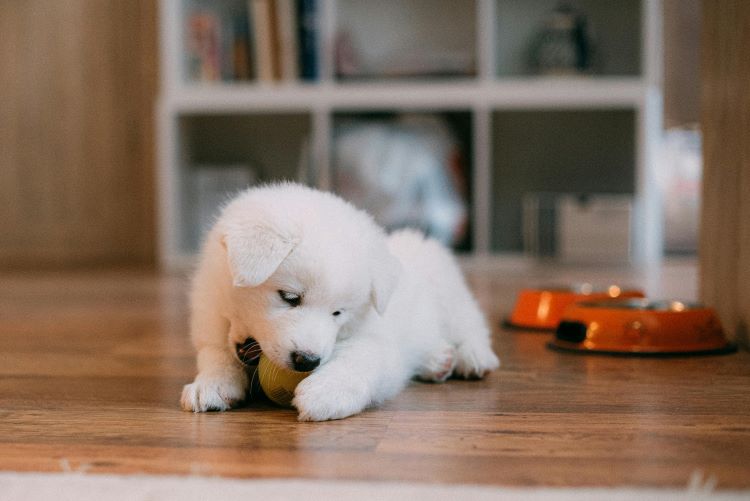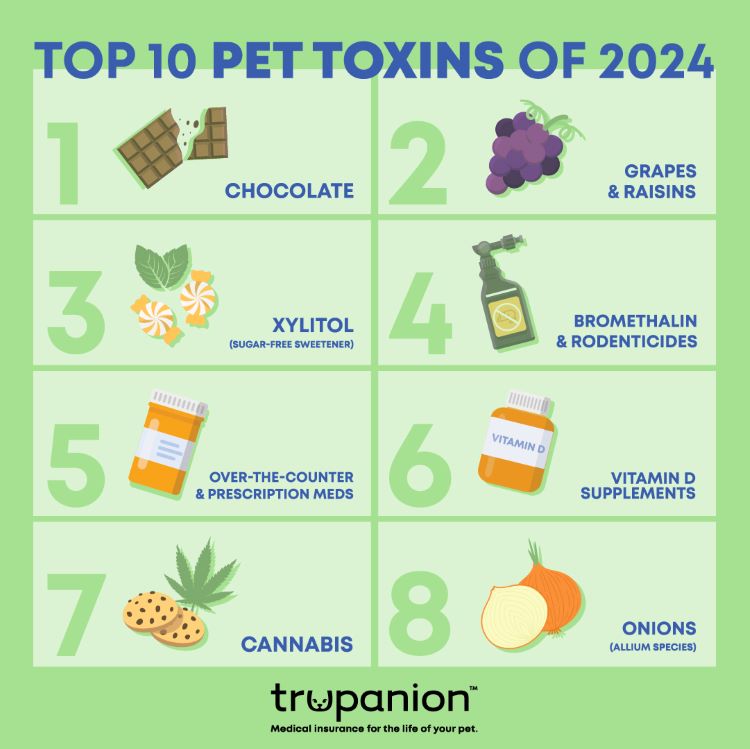Ready to help treat your pet to a healthy life?
Pet Poison Prevention Month: How to Protect Dogs & Cats
By : Brianna Gunter | Updated Mar 4, 2025

You love your pet and make an effort to keep them safe and healthy in everyday life. But when was the last time you did a check around the home for things that are toxic to them? Don’t fret if this hasn’t been on your mind — March is National Pet Poison Prevention Month in both the United States and Canada, and it’s the perfect time to take action!
The truth is that dogs and cats of all ages can easily come into contact with household poisons. Even if you feel your home is generally secure, all it takes is a small mistake for pets to come into contact with something harmful. To avoid emergency veterinary visits and potential tragedy, here’s a guide on what this month means along with pet poisoning data, common at-home risks, and how to protect your pal.
If you currently suspect your pet has ingested something harmful, call your veterinarian or the Pet Poison Helpline right away.
What is Pet Poison Prevention Month?
Pet Poison Prevention Month is an awareness campaign held annually in March, with the inclusion of National Animal Poison Prevention Week during the third week of the month (March 16 to 22 in 2025). This dates back to 1961, when US President John F. Kennedy and members of Congress started an awareness week intended to protect youth from accidental poisonings. Over the years, this initiative has grown to include pets, with “Pet Poison Prevention Month” being recognized as its own awareness campaign by 2014.
The goal is to educate pet owners about the seriousness of pet poisoning risks and raise awareness about specific foods, plants, medications, and other items that can lead to accidental toxicity in dogs, cats, and other animals. During Pet Poison Prevention Month, veterinarians, animal organizations, and pet care professionals often share information on how to create a pet-friendly and safe environment. They may provide tips on keeping harmful substances out of reach, identifying toxic plants, and being cautious about certain human foods that can be toxic to pets.
All in all, this awareness campaign serves to help pet owners take proactive measures rather than waiting to be reactive. Because pet poisonings require quick response and can be complicated to treat, prevention is key to ensuring the well-being of animals everywhere.
How common are pet poisonings?
Pet poisoning cases make up one of the most common reasons for emergency veterinary visit, according to VetsNow. Nine in 10 pet poisonings happen when pets are in their own home, and cases tend to spike during certain festive seasons like Halloween, Thanksgiving, and the December holidays.
Nevertheless, pet owners should be vigilant at all times. Thousands of pet poisoning cases occur every year across North America — the ASPCA Animal Poison Control Center (APCC) alone reported receiving calls about over 365,000 items pets were exposed to in 2024.
According to Trupanion claims data, the most commonly claimed toxicity in pets for the year of 2024 was chocolate ingestion. Food-related pet poisoning cases are likewise more common than those resulting from household cleaners, pharmaceuticals, and pest control products.

Trupanion claims data also shows that puppies and kittens are over twice as likely to have plant-related toxicity claims than their older counterparts.
Signs of poisoning in pets
Signs of poisoning in dogs and cats can vary depending on the size of your pet and how much of the substance they have consumed or come into contact with. Remember — even skin contact can be potentially harmful when it comes to chemicals. If your pet is experiencing any of the following symptoms, it’s time to seek medical care:
- Vomiting or gagging
- Diarrhea
- Unexplained bleeding or bruising
- Convulsions
- Difficulty breathing
- Swelling
- Fainting / losing consciousness
- Extreme fatigue or malaise
- Change in color of gums or mucous membranes
- Change in personality / erratic behavior
- Loss of coordination or “drunken” behavior
Your pet may exhibit no signs of poisoning if they’ve only just come into contact with something harmful. But don’t wait for them to start getting sick — err on the side of caution and get veterinary attention right away. Do not induce vomiting in your pet unless specifically instructed to do so by your veterinary team.

5 pet poison prevention tips
The sheer amount of potential poison dangers for pets in your home can be quite scary, and you may even feel a bit overwhelmed going down the list. But as a pet parent, there are many things you can do to help keep your four-legged pal free from harm. Start by identifying potential dangers and putting them out of reach for your pet. All cleaning products should be stored in a lockable cupboard or closet, for example. If you have open shelves in your kitchen or pantry, store hazardous items up high where your pet can’t jump. Likewise, auto products should never leave the garage and should have their own secure storage space. Mitigate your pet’s risk of at-home poisoning by following these tips:
1. Secure common household poisons
One of the first things you should do is secure any hazardous substances (including cleaning products, pesticides, medications, and food) in your home. Keep them out of reach and locked away in cabinets or drawers. Remember, even plants can be toxic to pets, so keep them out of reach of curious paws. It’s also important to keep your pet’s food and water bowls away from areas where cleaning chemicals or medications are stored.
2. Clean up before leaving an area unattended
Whether cooking in the kitchen, doing some Sunday cleaning, or practicing arts and crafts with the kids, never leave things out unattended. Always put everything away and double-check for any sneaky spills or lingering products before leaving the room. When cleaning, keep pets out of the area and allow surfaces to dry fully before letting them back in.
3. Talk with your veterinarian
Not sure if something is toxic to your pet or not? Just ask your veterinarian! They may likewise have important information about nearby emergency services for pets as well as the most common risks in your area. It’s also a good idea to ask for additional tips on how you can best help your particular pet in the event of a potential poisoning.
4. Get the whole family on board
Nobody wants their pet to get sick, but accidents happen nonetheless. Before anyone in your home inadvertently puts your furry friend at risk, make sure you’re all on the same page with pet poison prevention. Keep in mind that children may need multiple reminders about not leaving potential hazards out or not sharing food with dogs and cats. You’ll want to supervise young children around pets regardless.
5. Prepare for emergencies
Pets are unpredictable, and accidents can still happen even when you are taking preventative measures. While knowing how to spot the signs of toxicity in pets is an important first step, you’ll need to act quickly to get your pet the treatment they need. Here are some tips you can use to make sure you’re prepared in the event of emergency.
Know where to get treatment for your pet
Make a list (with contact info) of the nearest veterinary offices, whether or not this includes your usual vet — when it comes to toxic ingestion or exposure in pets, time is of the essence! Be sure to look up 24/7 emergency animal hospitals in your area and include these as well.
Add these numbers to your phone
Take just a few minutes to add some important numbers to your phone. You may also want to make a list and add them to your fridge or somewhere else that is visible. In the event of a poisoning emergency, having these on hand could be lifesaving for your dog or cat:
- Pet Poison Helpline: (855) 764-7661 ($85 incident fee applies)
- ASPCA Animal Poison Control Center: (888) 426-4435 (consultation fee may apply)
- Your pet health insurance provider (if you have Trupanion, you can call 24/7!)
- The nearest emergency animal hospitals in your area
Sign up for pet health insurance
The last thing you want during a health crisis for your pet is to worry about how to afford veterinary treatment. This is why having a good pet medical insurance policy in place ahead of time is so important. Having this coverage in place will let you focus on what really matters — taking care of your pet and getting them the treatment they need.

Spread pet poison prevention awareness
This time of year isn’t just about your own pet. You can help save lives by spreading awareness to your fellow pet owners. Share tips on prevention, send links to this article, and encourage others to consider pet insurance coverage for an added layer of protection. Pet poisonings are unpredictable, and accidents can happen at any time. Spreading awareness helps save the lives of furry friends everywhere.
